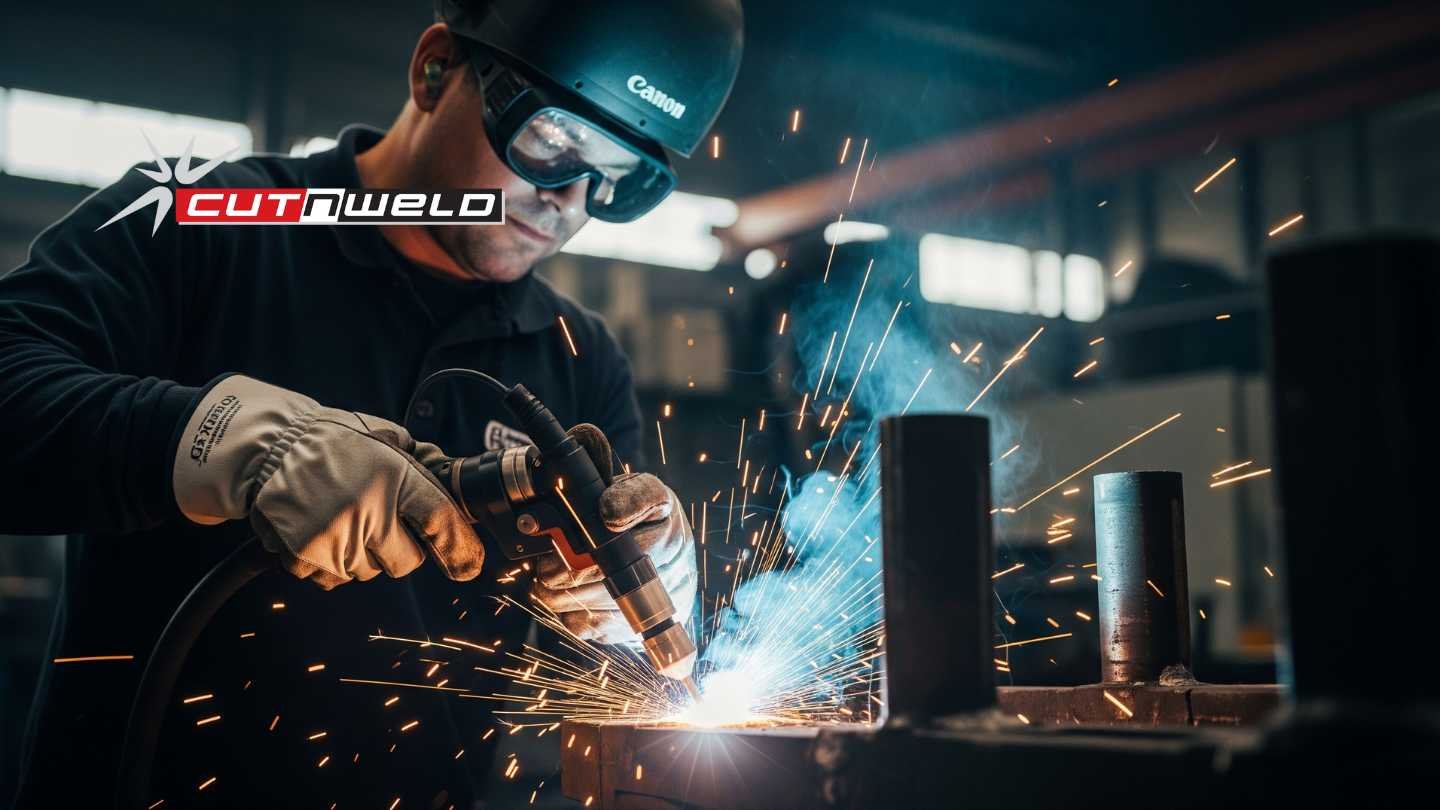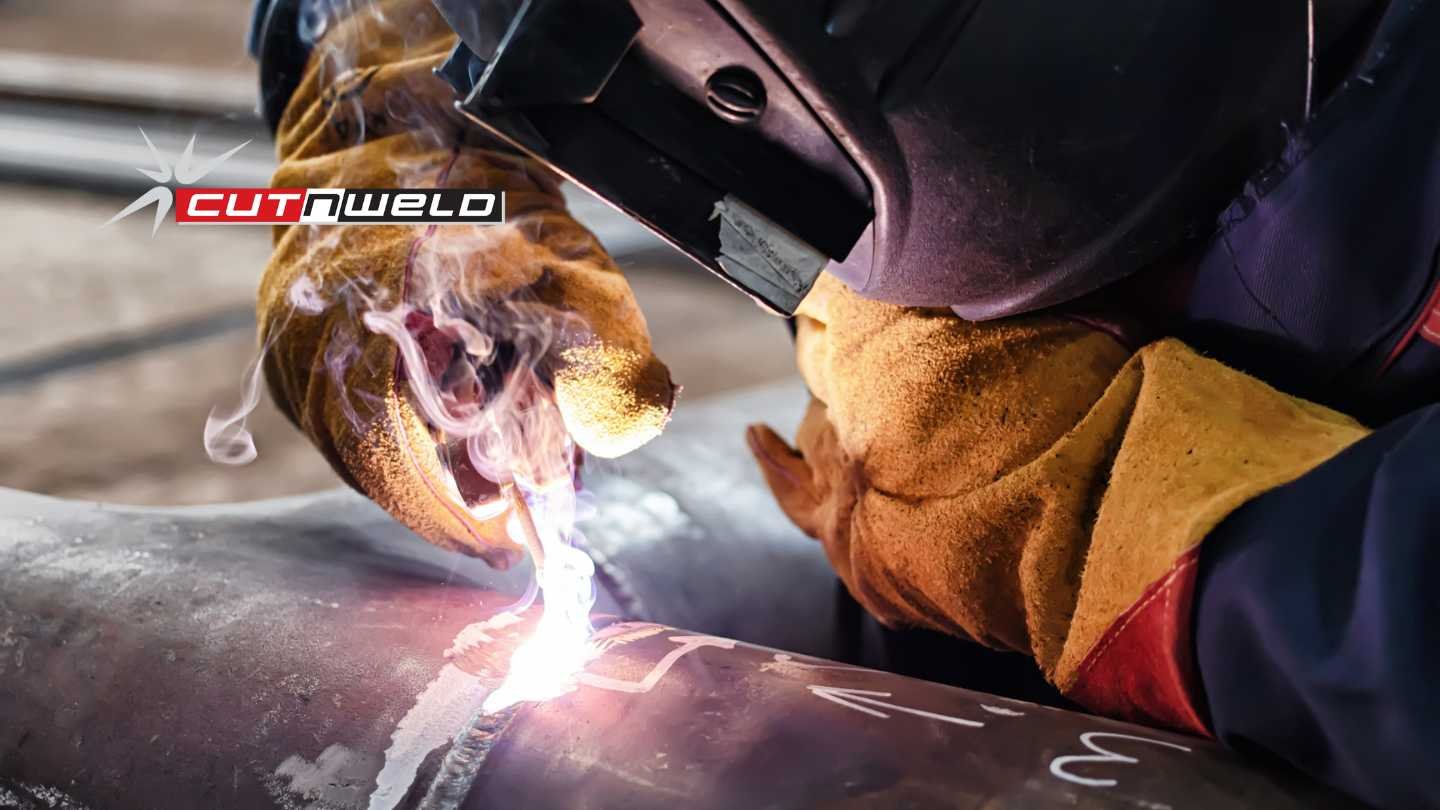This article discusses the MIG and TIG processes which are both arc welding processes. They use electric arc and electrical resistance to melt the base and filler metals and make a welding joint.
You will learn what they are, how they work, and their advantages and disadvantages.
To run these processes, you need a closed circuit. This can be done by attaching a ground clamp to the metal piece and attaching the torch to the holder. The torch completes the electrical circuit and can heat the metal piece.
In welding applications, electricity flows from the power source or the weld to the workpiece.
The electrode lead is connected to the negative terminal of the welding equipment using DCEN (Direct current electrode negative). The positive terminal is connected to the ground clamp lead. From the negative to the positive, electricity flows. When the arc is ready to go from the negative electrode to the positive metal piece, it first travels via the electrode in the welder, then it is drawn in by the positive ground clamp that is fastened to the metal piece.
The electrode lead is connected to the positive terminal of the welder using DCEP (Direct Current Electrode Positive). The negative is connected to the ground clamp lead. There is no change since electricity flows from negative to positive according to the laws of physics. When the positive electrode comes into contact with the metal piece, the current jumps from the metal to the electrode, creating the arc. The electricity enters the metal piece through the ground clamp first.
An AC (Alternating Current) is an electric current that reverses its direction many times per second. With AC welding, because the magnetic field and current rapidly reverse-direction, there is no net deflection of the arc.
The metal melts because of the electrical current flow’s resistance, but whether we’re utilising DCEP, DCEN, or AC makes a significant difference.
MIG Welding
MIG welding is the simplest welding procedure to learn. It uses a wire feeding mechanism, and the supplied wire serves as both an electrode and a filler metal. The procedure calls for a shielding gas (usually an Argon and CO2 mixture, but it can also be pure Argon for better arc quality or pure CO2 if welding on a budget), supports several modes of metal transfer, can weld thick or thin materials and has a fast metal deposition rate. MIG is one of the most widely used processes in the welding industry.
How MIG Works
A MIG welder’s internal wire feeding system feeds lead from a spool of wire into the MIG gun. The wire serves as an electrode and filler metal and is electrically hot. For gas metal arc welding, DCEP is necessary; if DCEN is used inadvertently, the arc will be unpredictable and produce globby welds.
Besides the wire, the MIG gun also supplies the shielding gas to protect the weld pool. The gas cylinder is connected to the welder via a gas hose. The gas is released once you press the trigger on the MIG gun so that the tip of the MIG torch feeds wire and the shielding gas into the joint. MIG welding is primarily used to weld steel, but you can also weld aluminium using a spool gun, or a special liner for the regular MIG gun.
MIG Advantages and Disadvantages
MIG welding is used to join large and thick materials, using a consumable wire that is boththe electrode and filler material. It is faster than TIG welding, creating shorter productiontimes for welds that require little or no cleaning and finishing. However, MIG welds are not as defined, strong, or aesthetically pleasing as TIG welding.
TIG Welding
TIG welding is more difficult to master than MIG. The process is also gas shielded, but the wire is fed manually. A non-consumable tungsten electrode is used working with DC and AC output. TIG is slower than MIG, but it also produces cleaner and beautifully-looking welds and joins the biggest variety of metals.
How TIG Works
The TIG torch comprises multiple elements, but the most important is the tungsten electrode and the cup. The high-frequency (HF) arc start is the cleanest method because the arc jumps from the tungsten to the metal piece avoiding physical contact, without contaminating the weld pool. The tungsten electrode sticks out a little from the cup and starts an arc in three ways: scratch start, lift start, or HF arc start. Tungsten electrodes are made up of different chemical compounds. These compounds affect the arc shape and the resulting weld. Each tungsten electrode type is meant for a specific use case. The tungsten electrode tip shape directly impacts the arc shape and the resulting weld.
Depending on the desired outcome, the used tungsten, and the welded metal, the process is done using DCEN, DCEP, or AC. The AC is used to weld aluminium.
The DCEN provides a current flow to the tungsten electrode, while the DCEP concentrates heat on the tungsten electrode. In other words, the DCEN focuses the heat onto the tungsten electrode, while the DCEP focuses the heat onto the tungsten electrode. However, when doing DC TIG, most of the welding is done on DCEN, not DCEP, because otherwise, the tungsten will touch the molten metal, and you rather want the ball on the end.
The cup on the welding torch distillates the shielding gas over the puddle, and the heat-affected zone (HAZ). The pure Argon gas is then fed either through the TIG welder or directly to the TIG torch.
The focused heat will melt the base metal when you start the arc, while the shielding gas will protect it from the air around it. If a filler material is required, feed the filler rod into the weld pool using the opposite hand, dodging the wire to prevent it from coming into contact with the electrode.
TIG Advantages and Disadvantages
Using a non-consumable tungsten electrode and an optional, separate filler rod, TIG welding is a flexible technology that can combine a variety of small and thin materials. TIG welding takes longer than MIG welding, which increases production times and thus can result in more costs. It requires a lot of skill to perform the correct weld with precision. With more control over the welding process, the result is more aesthetically pleasing than MIG welds.
Cut-N-Weld stocks a wide variety of consumables, state-of-the-art equipment, accessories, and quality protective gear to provide you with the best welding and cutting solutions. Take advantage of buying directly from the distributor and visit our online store today.





